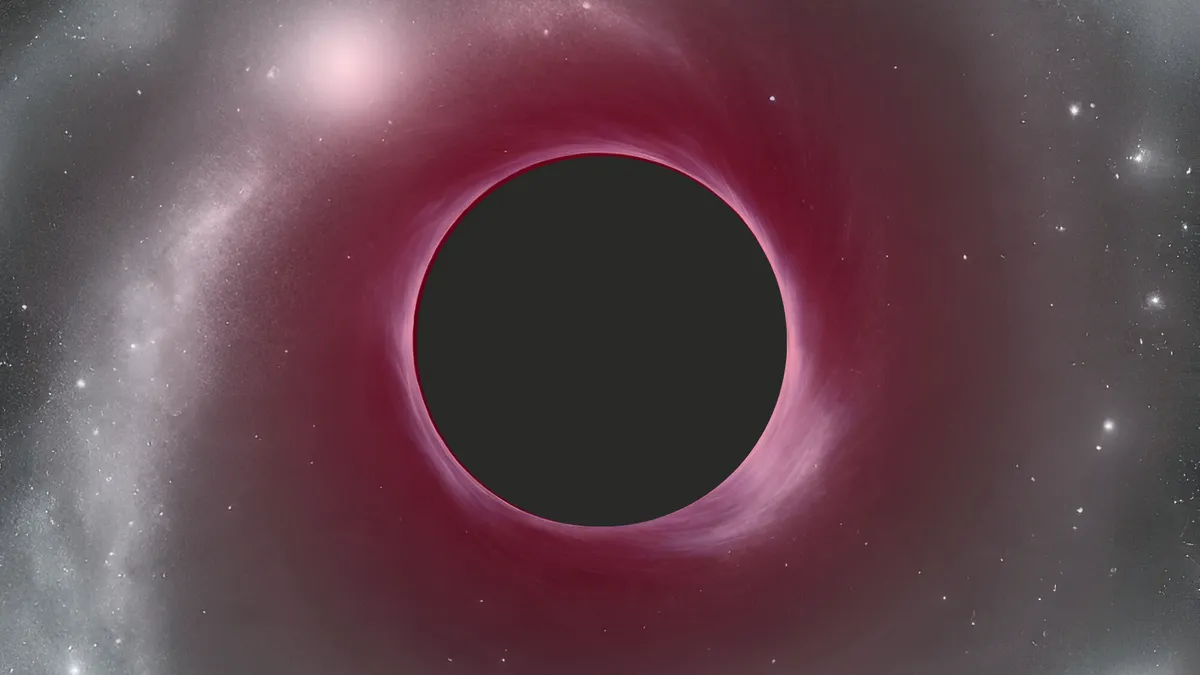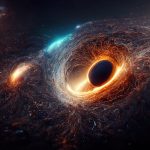Key Takeaways:
- JWST discovered a supermassive black hole 12.9 billion light-years away, existing only 700 million years after the Big Bang.
- The black hole appears very red due to redshift and is rapidly consuming surrounding gas and dust.
- The black hole is 40 million times the Sun’s mass, unexpectedly large for its young galaxy.
- Light from the quasar was magnified by a foreground galaxy cluster, allowing JWST to see it.
- This discovery adds to the puzzle of how supermassive black holes formed and grew so quickly in the early universe.

Scientists have found a supermassive black hole that is “extremely red” and expanding in the dark early universe using the James Webb Space Telescope (JWST).
The expanding universe is responsible for the supermassive black hole’s red color when observed approximately 700 million years after the Big Bang. In this instance, light traveling toward us is “redshifted,” indicating that a thick layer of gas and dust is enveloping the black hole as the universe expands outward in all directions.
The mass of the supermassive black hole was also determined by the astronomy team led by Lukas Furtak and Adi Zitrin of the Ben-Gurion University of the Negev through the examination of JWST data. It is surprisingly massive for the galaxy it lives in, at about 40 million times the mass of the sun.
The supermassive black hole, which is about 12.9 billion light-years from Earth, is quickly consuming the gas and dust in its immediate vicinity, the team also discovered. Stated differently, it is expanding.
“We were very excited when JWST started sending its first data. We were scanning the data that arrived for the UNCOVER program, and three very compact yet red-blooming objects prominently stood out and caught our eyes,” Furtak said in a statement. “Their ‘red-dot’ appearance immediately led us to suspect that it was a quasar-like object.”
The ‘three red dots’
Massive amounts of matter surround supermassive black holes like this one to form quasars. The black hole is gradually fed by this matter, which forms an accretion disk, a disk of gas and dust. The immense gravitational influence of the black hole churns this matter, generating intense temperatures and causing it to glow.
Furthermore, matter that escapes the supermassive black hole is directed toward the poles of the cosmic titan. In these regions, particles accelerate into highly collimated jets that approach the speed of light. Bright electromagnetic emissions accompany the eruptions as these relativistic jets are blasted out.
These phenomena explain why quasars powered by supermassive black holes in active galactic nuclei (AGN) are frequently so bright that the total amount of light emitted by all the stars in the surrounding galaxy is frequently surpassed by the light emitted by the quasars.
This specific supermassive black hole appears as a small point in JWST data due to the massive amount of radiation it is emitting.
The object was not a typical star-forming galaxy, according to color analysis. The statement quoted Rachel Bezanson, co-leader of the UNCOVER program and professor at the University of Pittsburgh, as saying, “This further supported the supermassive blackhole hypothesis.” “Together with its compact size, it became evident this was likely a supermassive black hole, although it was still different from other quasars found at those early times.”
Even with the JWST’s powerful infrared eye, the early quasar would not have been visible without a little assistance from an effect that Albert Einstein predicted in 1915.
Einstein’s lens
According to Einstein’s general theory of relativity, mass-producing objects distort space and time, which are actually combined to form a single entity known as “spacetime.” According to the theory, that curvature is what gives rise to gravity. The curvature of spacetime becomes more “extreme” with increasing object mass.
Therefore, this curvature not only instructs planets on how to orbit stars and their home galaxies’ centers, but it also modifies the paths taken by light coming from those stars.
Light’s path is more “bent” the closer it gets to the mass object. Thus, a foreground object, also known as a “lensing object,” can bend different light paths from a single background object, changing the appearance of the background object’s location. The background object may occasionally even appear more than once in the same sky image due to the effect. In other cases, the background object is magnified simply by the light from it being amplified.
This phenomenon is known as “gravitational lensing.”

In this instance, light from background galaxies that are otherwise too far away to see was amplified by the JWST using a galaxy cluster known as Abell 2744 as a foreground lensing body. This displayed the intensely red quasar that they had focused on, which had initially appeared as three red dots.
“We used a numerical lensing model that we had constructed for the galaxy cluster to determine that the three red dots had to be multiple images of the same background source, seen when the universe was only some 700 million years old,” Zitrin explained.

Further analysis of the background source revealed its light must have come from a compact region.
“All the light of that galaxy must fit within a tiny region the size of a present-day star cluster. Researchers Jenny Greene of Princeton University and a member of the team said in the statement, “The gravitational lensing magnification of the source gave us exquisite limits on the size.” “Even packing all the possible stars into such a small region, the black hole ends up being at least 1% of the total mass of the system.”
The finding raises more questions about how supermassive black holes, which can have masses up to billions or even millions of times that of the sun, were able to expand to such enormous proportions in the early universe.
“Several other supermassive black holes in the early universe have now been found to show a similar behavior, which leads to some intriguing views of the black hole and host galaxy growth, and the interplay between them, which is not well understood,” Greene said.
Over time, a multitude of “little red dots” have been identified by the JWST. These could also indicate feeding supermassive black hole-powered quasars in the early universe, maybe meaning a striking black hole growth conundrum could soon be solved.
“In a way, it’s the astrophysical equivalent of the chicken and egg problem,” Zitrin said. “We do not currently know which came first — the galaxy or black hole, how massive the first black holes were, and how they grew.”
The team’s findings were released in the journal Nature.


